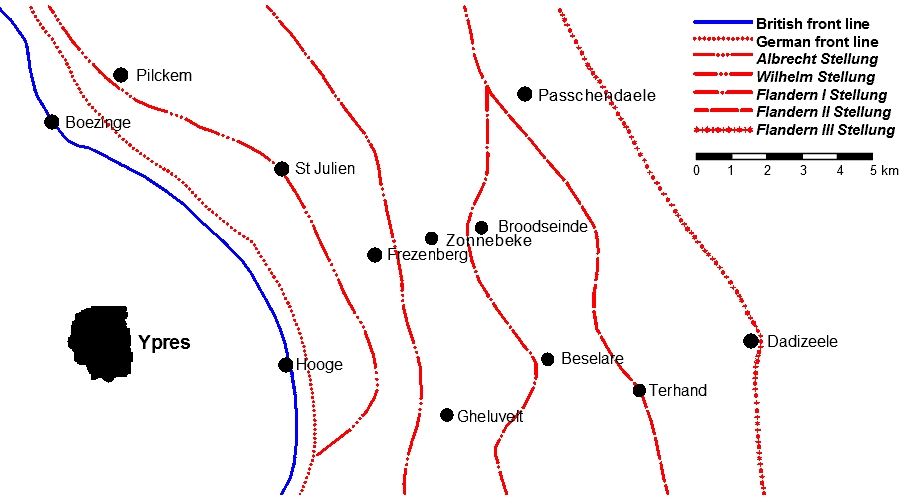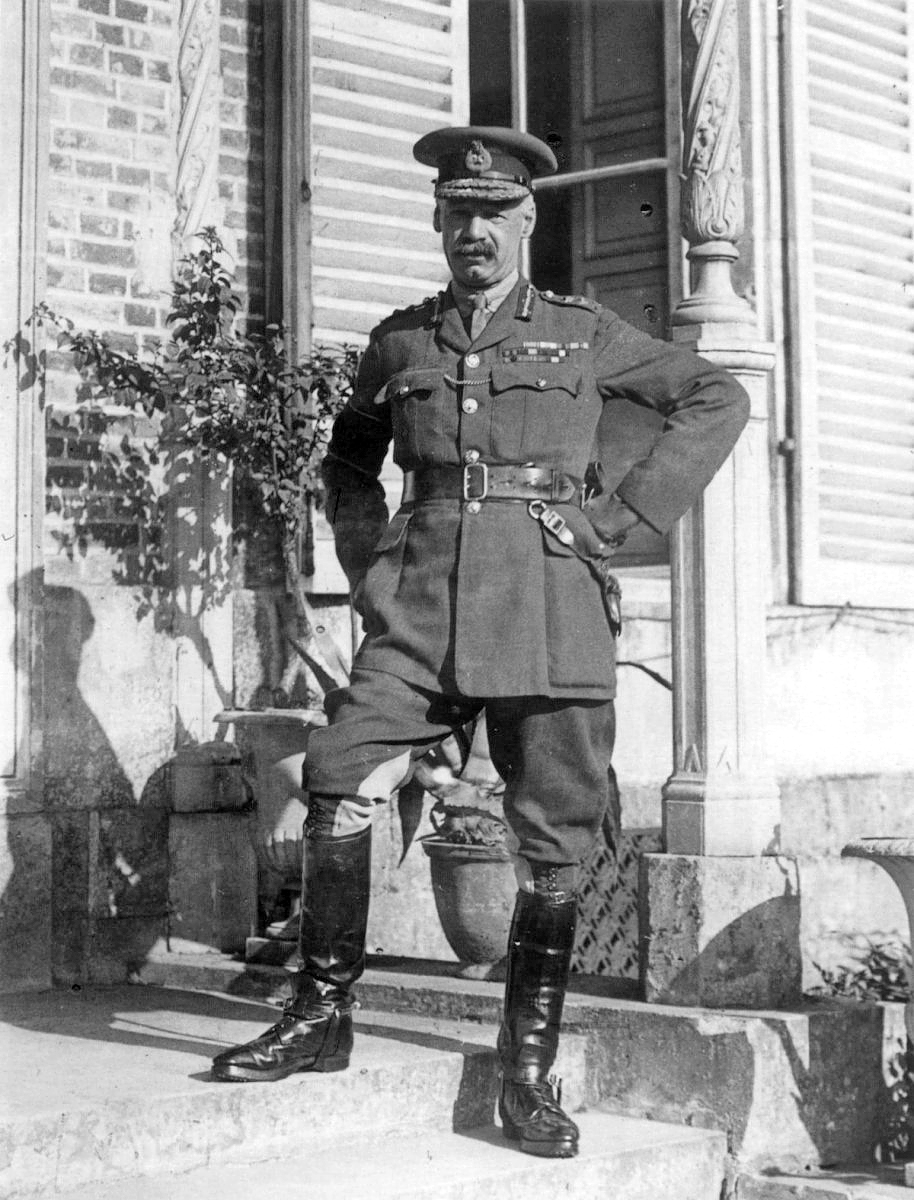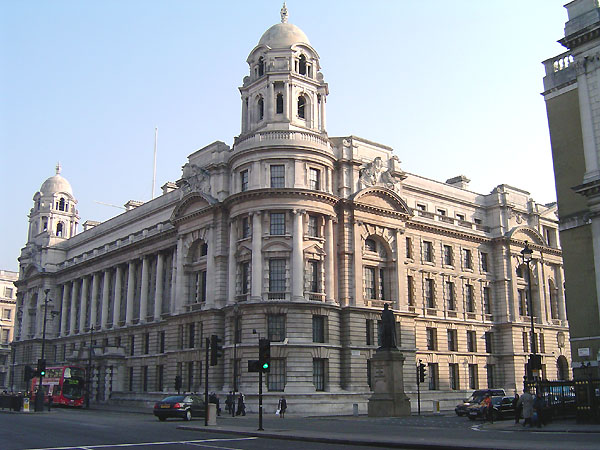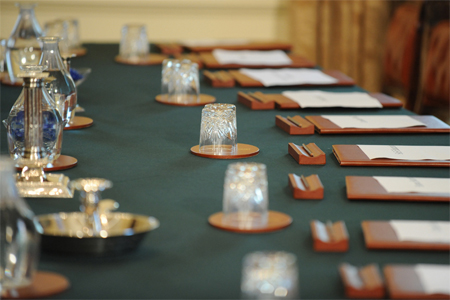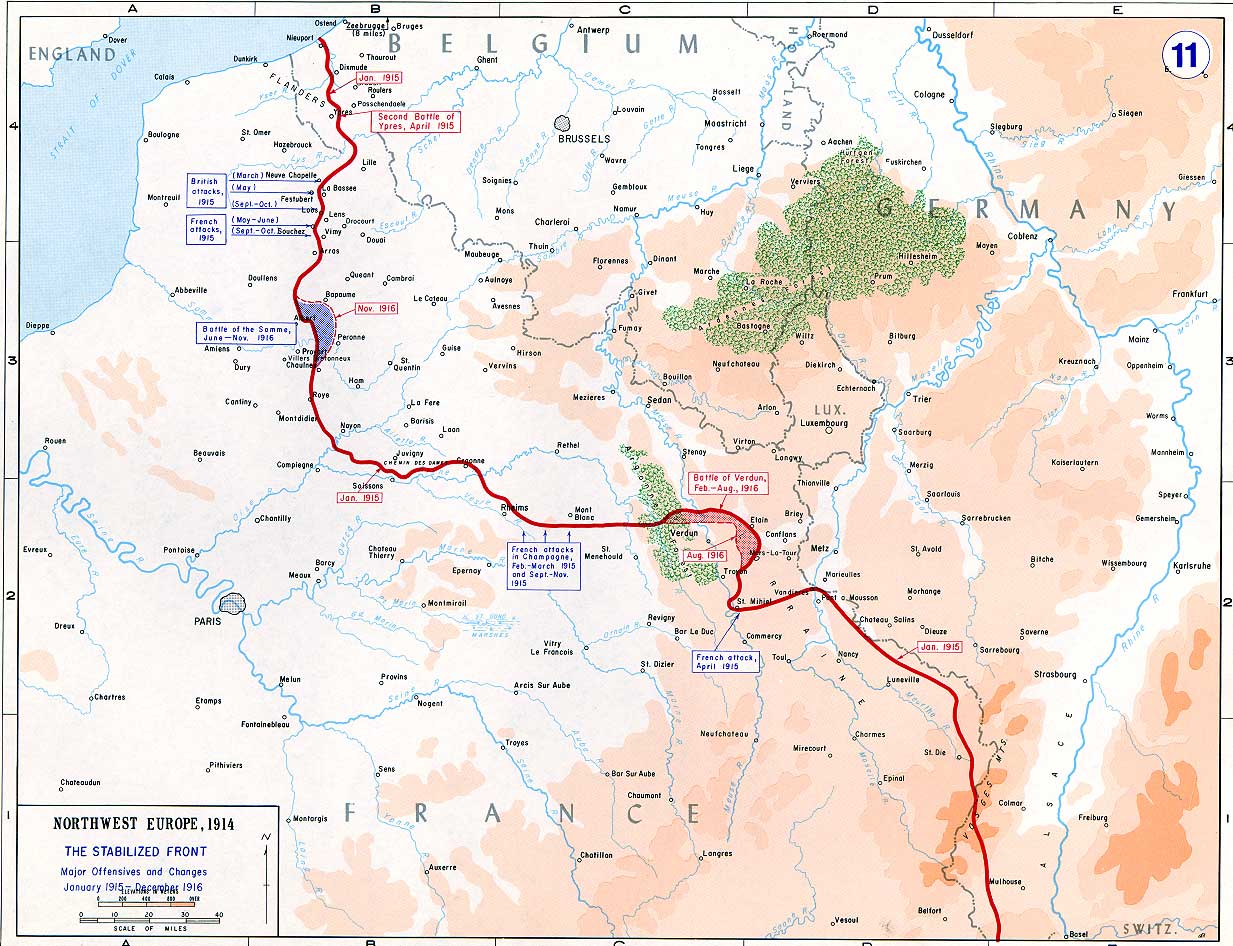|
Pilckem Ridge
The Battle of Pilckem Ridge (31 July – 2 August 1917) was the opening attack of the Third Battle of Ypres in the First World War. The British Fifth Army (United Kingdom), Fifth Army, supported by the Second Army (United Kingdom), Second Army on the southern flank and the French (First Army) on the northern flank, attacked the German 4th Army (German Empire), 4th Army, which defended the Western Front (World War I), Western Front from Lille northwards to the Ypres Salient in Belgium and on to the North Sea coast. On 31 July, the Anglo-French armies captured Pilckem (Flemish dialects, Flemish: Pilkem) Ridge and areas on either side, the French attack being a great success. After several weeks of changeable weather, heavy rain fell during the afternoon of 31 July. In the XIX Corps (United Kingdom), XIX Corps area in the centre and on the right of XVIII Corps (United Kingdom), XVIII Corps, three reserve brigades advanced from the black line to the main objective (green line) and p ... [...More Info...] [...Related Items...] OR: [Wikipedia] [Google] [Baidu] |
Battle Of Passchendaele
The Third Battle of Ypres (; ; ), also known as the Battle of Passchendaele ( ), was a campaign of the First World War, fought by the Allies of World War I, Allies against the German Empire. The battle took place on the Western Front (World War I), Western Front, from July to November 1917, for control of the ridges south and east of the Belgian city of Ypres in West Flanders, as part of a strategy decided by the Entente at conferences in November 1916 and May 1917. Passendale, Passchendaele lies on the last ridge east of Ypres, from Roulers (now Roeselare), a junction of the Bruges-(Brugge)-to-Kortrijk railway. The station at Roulers was on the main supply route of the German 4th Army (German Empire), 4th Army. Once Passchendaele Ridge had been captured, the Allied advance was to continue to a line from Thourout (now Torhout) to Couckelaere (Koekelare). Further operations and a British supporting attack along the Belgian coast from Nieuport (Nieuwpoort, Belgium, Nieuwpoort), ... [...More Info...] [...Related Items...] OR: [Wikipedia] [Google] [Baidu] |
North Sea
The North Sea lies between Great Britain, Denmark, Norway, Germany, the Netherlands, Belgium, and France. A sea on the European continental shelf, it connects to the Atlantic Ocean through the English Channel in the south and the Norwegian Sea in the north. It is more than long and wide, covering . It hosts key north European shipping lanes and is a major fishery. The coast is a popular destination for recreation and tourism in bordering countries, and a rich source of energy resources, including wind energy, wind and wave power. The North Sea has featured prominently in geopolitical and military affairs, particularly in Northern Europe, from the Middle Ages to the modern era. It was also important globally through the power northern Europeans projected worldwide during much of the Middle Ages and into the modern era. The North Sea was the centre of the Viking Age, Vikings' rise. The Hanseatic League, the Dutch Golden Age, Dutch Republic, and Kingdom of Great Britain, Brita ... [...More Info...] [...Related Items...] OR: [Wikipedia] [Google] [Baidu] |
Henry Rawlinson, 1st Baron Rawlinson
General Henry Seymour Rawlinson, 1st Baron Rawlinson, (20 February 1864 – 28 March 1925), known as Sir Henry Rawlinson, 2nd Baronet between 1895 and 1919, was a senior British Army officer in the First World War who commanded the Fourth Army of the British Expeditionary Force at the battles of the Somme (1916) and Amiens (1918) as well as the breaking of the Hindenburg Line (1918). He commanded the Indian Army from 1920 to 1925. Early life Rawlinson was born at Trent Manor in Dorset on 20 February 1864. His father, Sir Henry Rawlinson, 1st Baronet, was an Army officer, and a renowned Middle East scholar who is generally recognised as the father of Assyriology. His mother was Louisa Caroline Harcourt Seymour (1828-1889). He received his early formal education at Eton College. Early military career After passing out from the Royal Military College, Sandhurst, Rawlinson entered the British Army as a lieutenant in the King's Royal Rifle Corps in India on 6 February 1884. H ... [...More Info...] [...Related Items...] OR: [Wikipedia] [Google] [Baidu] |
General (United Kingdom)
General (or full general to distinguish it from the lower general officer ranks) is the highest rank achievable by serving officers of the British Army and the Royal Marines. The rank can also be held by Royal Marines officers in tri-service posts, for example, Generals Sir Gordon Messenger and Gwyn Jenkins, Sir Gwyn Jenkins, former Vice-Chief of the Defence Staff (United Kingdom), Vice-Chiefs of the Defence Staff. It ranks above Lieutenant-general (United Kingdom), lieutenant-general and, in the Army, is subordinate to the rank of Field marshal (United Kingdom), field marshal, which is now only awarded as an honorary rank. The rank of general has a NATO-code of Ranks and insignia of NATO, OF-9, and is a four-star rank. It is equivalent to a Admiral (Royal Navy), full admiral in the Royal Navy or an air chief marshal in the Royal Air Force. Officers holding the ranks of Lieutenant-general (United Kingdom), lieutenant-general and Major-general (United Kingdom), major-general m ... [...More Info...] [...Related Items...] OR: [Wikipedia] [Google] [Baidu] |
War Office
The War Office has referred to several British government organisations throughout history, all relating to the army. It was a department of the British Government responsible for the administration of the British Army between 1857 and 1964, at which point its functions were transferred to the new Ministry of Defence (United Kingdom), Ministry of Defence (MoD). This article contains text from this source, which is available under th Open Government Licence v3.0 © Crown copyright It was equivalent to the Admiralty (United Kingdom), Admiralty at that time, which was responsible for the Royal Navy (RN), and (much later) the Air Ministry, which oversaw the Royal Air Force (RAF). The name 'Old War Office' is also given to the former home of the department, located at the junction of Horse Guards Avenue and Whitehall in central London. The landmark building was sold on 1 March 2016 by HM Government for more than British pound, £350 million, on a 250-year lease for conversion int ... [...More Info...] [...Related Items...] OR: [Wikipedia] [Google] [Baidu] |
Admiralty (United Kingdom)
The Admiralty was a department of the Government of the United Kingdom that was responsible for the command of the Royal Navy. Historically, its titular head was the Lord High Admiral – one of the Great Officers of State. For much of its history, from the early 18th century until its abolition, the role of the Lord High Admiral was almost invariably put "in commission" and exercised by the Lords Commissioner of the Admiralty, who sat on the governing Board of Admiralty, rather than by a single person. The Admiralty was replaced by the Admiralty Board in 1964, as part of the reforms that created the Ministry of Defence and its Navy Department (later Navy Command). Before the Acts of Union 1707, the Office of the Admiralty and Marine Affairs administered the Royal Navy of the Kingdom of England, which merged with the Royal Scots Navy and then absorbed the responsibilities of the Lord High Admiral of the Kingdom of Scotland with the unification of the Kingdom of Great B ... [...More Info...] [...Related Items...] OR: [Wikipedia] [Google] [Baidu] |
British Cabinet
The Cabinet of the United Kingdom is the senior decision-making body of the Government of the United Kingdom. A committee of the Privy Council, it is chaired by the Prime Minister and its members include Secretaries of State and senior Ministers of State. Members of the Cabinet are appointed by the Prime Minister and are by convention chosen from members of the two houses of the Parliament of the United Kingdom, the House of Commons and the House of Lords. The Ministerial Code says that the business of the Cabinet (and United Kingdom cabinet committee, cabinet committees) is mainly questions of major issues of policy, questions of critical importance to the public and questions on which there is an unresolved argument between departments. The work of the Cabinet is scrutinised by the Official Opposition Shadow Cabinet (United Kingdom), Shadow Cabinet, made up of members of the His Majesty's Most Loyal Opposition, Official Opposition. History Until at least the 16th centur ... [...More Info...] [...Related Items...] OR: [Wikipedia] [Google] [Baidu] |
Belgium
Belgium, officially the Kingdom of Belgium, is a country in Northwestern Europe. Situated in a coastal lowland region known as the Low Countries, it is bordered by the Netherlands to the north, Germany to the east, Luxembourg to the southeast, France to the south, and the North Sea to the west. Belgium covers an area of and has a population of more than 11.8 million; its population density of ranks List of countries and dependencies by population density, 22nd in the world and Area and population of European countries, sixth in Europe. The capital and Metropolitan areas in Belgium, largest metropolitan region is City of Brussels, Brussels; other major cities are Antwerp, Ghent, Charleroi, Liège, Bruges, Namur, and Leuven. Belgium is a parliamentary system, parliamentary constitutional monarchy with a complex Federation, federal system structured on regional and linguistic grounds. The country is divided into three highly autonomous Communities, regions and language areas o ... [...More Info...] [...Related Items...] OR: [Wikipedia] [Google] [Baidu] |
Flanders
Flanders ( or ; ) is the Dutch language, Dutch-speaking northern portion of Belgium and one of the communities, regions and language areas of Belgium. However, there are several overlapping definitions, including ones related to culture, language, politics, and history, and sometimes involving neighbouring countries. The demonym associated with Flanders is Flemings, Fleming, while the corresponding adjective is Flemish people, Flemish, which can also refer to the collective of Dutch dialects spoken in that area, or more generally the Belgian variant of Standard Dutch. Most Flemings live within the Flemish Region, which is a federal state within Belgium with its own elected government. However, like Belgium itself, the official capital of Flanders is the City of Brussels, which lies within the Brussels, Brussels-Capital Region, not the Flemish Region, and the majority of residents there are French speaking. The powers of the Flemish Government in Brussels are limited mainly ... [...More Info...] [...Related Items...] OR: [Wikipedia] [Google] [Baidu] |
Battle Of The Menin Road Ridge
The Battle of the Menin Road Ridge, sometimes called "Battle of the Menin Road", was the third British general attack of the Third Battle of Ypres in the First World War. The battle took place from 20 to 25 September 1917, in the Ypres Salient in Belgium on the Western Front (World War I), Western Front. During the pause in British and French general attacks from late August to 20 September, the British changed some infantry tactics, adopting the Bounding overwatch#Leapfrogging, leap-frog method of advance. Waves of infantry stopped once they reached their objective and consolidated the ground, while supporting waves passed through the objective to attack the next one and the earlier waves became the tactical reserve. General adoption of the method was made possible when more artillery was brought into the Salient (military), salient, by increasing the number of aircraft involved in close air support and by the Royal Flying Corps giving the tasks of air defence, contact-patrol, ... [...More Info...] [...Related Items...] OR: [Wikipedia] [Google] [Baidu] |
Eingreif
Eingreif division () is a term for a type of German Empire, German German Army (German Empire), Army formation of the First World War, which developed in 1917, to conduct immediate counterattack, counter-attacks () against enemy troops who broke into a defensive position being held by a front-holding division () or to conduct a methodical counter-attack () 24–48 hours later. Attacks by the French and British armies against the on the Western Front (World War I), Western Front had been met in 1915 and 1916 by increasing the number and sophistication of trench networks, the original improvised defences of 1914 giving way to a centrally-planned system of trenches in a trench-position and then increasing numbers of trench-positions, to absorb the growing firepower and offensive sophistication of the Entente armies. During the Battle of the Somme (1 July – 18 November 1916), the use of defensive lines began to evolve into the defence of the areas between them, using the local troop ... [...More Info...] [...Related Items...] OR: [Wikipedia] [Google] [Baidu] |
XVIII Corps (United Kingdom)
The XVIII Corps was a British infantry formation during World War I. It was reactivated, briefly, in Cyprus during World War II as part of a military deception. History British XVIII Corps was formed in France in January 1917 under Lieutenant General Sir Ivor Maxse. From its formation, XVIII Corps Cavalry Regiment was provided by A and B Squadrons, South Irish Horse and B Squadron, 1/1st Hertfordshire Yeomanry. In May 1917, F Squadron South Irish Horse replaced the Herts Yeomanry, and XVIII Corps Cavalry Regiment was also known as 2nd South Irish Horse. It was dissolved in August 1917 when the South Irish Horse went to be retrained as infantry. XVIII Corps pursued the German forces to the Hindenberg Line and was then merged into VIII Corps in July 1918. In 1941, during World War 2, the XVII Corps was briefly reactivated as a fictional unit, as part of the Cyprus Defence Plan deception. However, it was later renamed XXV Corps. General officers commanding Commanders inc ... [...More Info...] [...Related Items...] OR: [Wikipedia] [Google] [Baidu] |
